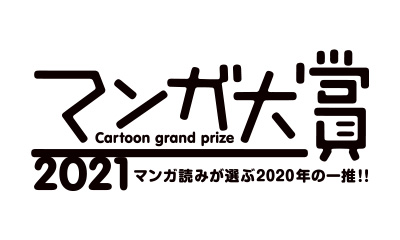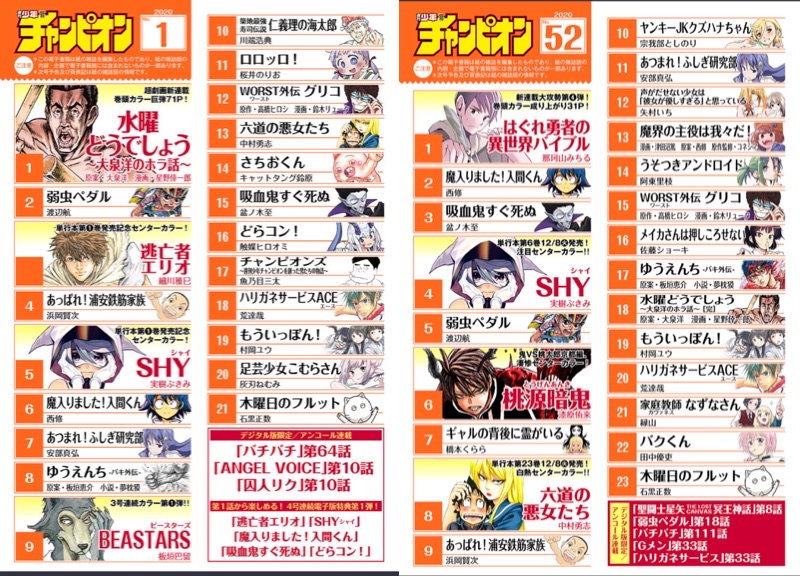Weekly Shonen Sunday opens the new decade with a stable lineup. So lets see its current line up.
Sousou no Frieren (Lead Color)
Detective Conan: Zero's Tea Time
MAO
Komi-san wa Komyushou Desu
Major 2nd
Yofukashi no Uta
Nokemono-tachi no Yoru (Color)
Ryuu to Ichigo
Maou-jou de Oyasumi
Aozakura Bouei Daigakukou Monogatari
Tonikaku Cawaii
Be Blues! - Ao ni Narei
Ponkotsu-chan Kenshochu
Kimi wa 008
Hoankan Evans no Uso (Color)
Souboutei Kowasu Beshi
Maiko-san Chi no Makanai-san
Alice in Borderland RETRY
Amano Megumi wa Suki Darake!
Switch
Sokyuu no Adriadne
Itoyan goto Naki
Zettai Karen Children
Youkai Giga
Tokaichi Hitoribocchi Nouen
ABSENT: Detective Conan, Daiku no Hatou
(Hiatus) Arata Kangatari
Instead of going down through the table of contents, I want to first analyse where the stability of Sunday comes from. As I see it a key component of this stability is obviously the presence of Detective Conan, a series with iconic cultural status which many people tune in on Saturdays evenings to watch its anime. Its incredibly successful anime is a factor in this but the manga also continues to sell well, it is currently Sunday best selling series and it has a towering presence over any other series in the magazine.
This strong popular magnetism of Detective Conan has meant spin off series have come to appear in the pages of Sunday as well. The most recent ones being Zero Tea's time and Wild Police Force whilst the latter has ended the former appears in the magazine infrequently but they nonetheless show how important Conan is for Sunday.
Komi-san is a strong series in Sunday's line up, sales wise it is still one of the best selling series, even if its sales seems to be in decline at the moment. The editors seem to have stepped back some of the attention they gave it earlier, probably to give space for the much newer series that have not found such levels of popularity. It continues, however ,to be one of the most popular Sunday series and one that many people wish to see animated someday to see it reach new heights but whether that will happen we will just have to wait and see.
Another series that could be said to be a strong weight lifter in the magazine is Kotoyama latest work 'Yofukashi no Uta.' It is a relatively new series in comparison to Komi but it has become a good stable seller in the magazine and whilst it has not reached the level of popularity that his previous work had in its peak yet, it sells really well in comparison to the rest of the magazine. Perhaps, with an anime in the future it could match or even surpass Dagashi's peak, but that is also something we will have to wait to see. However, neither Komi-san or Yokufashi are the second best selling in the magazine beneath Conan, after all that title is reserved for Major 2nd at least for the moment.
Major 2nd is similar in a way to Conan in that it is a very popular series, but unlike it, it is a sequel to the popular 'Major' baseball series that ran on Sunday in the past. Major 2nd following from its prequel was immediately popular since its debut and it continues to be one of the best selling series in Sunday even though it has being ongoing for a a few years already. It has during its current run received two anime seasons but these never boosted its sales to a large extent and the moment its sales seem to be on a downward trend. Despite this it is still a staple in the magazine albeit one that is boosted by its sequel status to an older popular work.
This brings us to other sports series in the magazine. Be Blues which has been ongoing for a long period, it is similar to Major 2nd in that it is a stable series for the magazine. It does not have the same level of success but it has managed to maintain a decent level of sales but its sales seem to have reached a peak and have since stagnated. It unlike Major 2nd has not had a anime adaptation but it is also by a veteran author with prior successes in Sunday in his curriculum.
Switch on the other hand is one of the younger series in the magazine that has established itself. Unlike Major 2nd or Be Blues, it is from a newbie author. It has nonetheless manage to claw for itself a space in Sunday via growing sales albeit it is still not a big selling series by any stretch of the imagination. It continues to slowly grow but the increase in sales comes in very small chunks and not in leaps which does not paint a picture of a series that will be a star for the magazine in the coming future, unless it of course receives an anime or gets a boost in sales from another source.
Going from one series that has been making space for itself in the magazine to another, lets move on to Frieren. Frieren has quickly managed to become a title with a lot of promise for Sunday by selling well right from the get go and its second place rank in Kono Manga ga Sugoi is sure to boost it sales further. Its a golden egg that has a promising future for Sunday. Likewise, Ryuu to Ichigo is also a newer series that started around the same time as Frieren, it has not managed to reach the anywhere the same level of popularity or sales. It has nonetheless established a space for itself in the magazine though it has only a passable level of sales at the moment. Hence, it is likely going to become a middling series in the magazine.
Talking about middling series the likes of Kim wa 008, Tonikaku Kawaii and Sleeping Princess all fit in this category, some are better fit than others however. Both Tonikaku kawaii and Sleeping Princess sell reasonably well, the former sells more but the latter is much further into its run and its sales had stagnated and declined over the last few years. However, both have received anime quite recently and neither has particularly found themselves moving up a tier in sales and Frieren looks set to easily outsell both in no time if it has not already. Kimi wa 008 on the other hand has lower sales than the other two but it has a stable level of sales that should sustain it for a reasonable run in the magazine. An anime for it might not be a remote possibility either even though the anime industry has moved on from such such eechi series in recent times though they still shows up to a certain degree every now and then.
Alongside these series is of course Ariadne and Maiko-san. Both these series have middling tier status in the magazine, the latter has been on going for longer and its sales are much better but like the others they both are established in the magazine but are not big hits. So they simply do not have the same sort of attention as the more popular stuff. Aozakura also fits alongside these series in the middle tier of the magazine. Likewise this is also the case for Amano Megumi. These series whilst not as big as some of the top selling stuff of the magazine, they form the majority of the magazine and for any magazine to sustain itself it needs to have a strong middle tier alongside the big titles. Sunday's middle tier has average sales for the most part with some highlights here and there, but through them the magazine shows a wide variety of genres that can capture different audiences.
Daiku no Hatou is a series, I wanted to talk about on its own. It is a series that has established itself in magazine in one way or another but its sales according to shoseki at least are rather poor. Of course, this does mean its sales are poor everywhere since shoseki does not cover every bookstore in Japan or digital sales at that. Clearly, the editors believe its popularity in magazine and its sales are appropriate enough for it to continue in the magazine till this day. Likewise this is the case with Nokemono-tachi, one of the newer series thats just passed its first anniversary in the magazine but its sales according to shoseki are not good but it continues in the magazine regardless. I do not believe people in the editorial department would keep really unpopular series in the magazine so I am sure these series have a level of popularity thats acceptable regardless of what shoseki might show.































